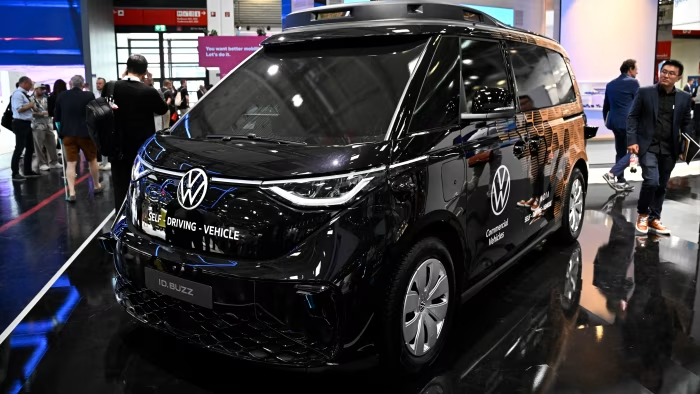Stay informed with free updates
Simply sign up to the Automobiles myFT Digest — delivered directly to your inbox.
Car giants from General Motors and Stellantis to Volkswagen are racing to develop autonomous vehicles as they seek to compete with Tesla and other new rivals on “the next frontier” of growth.
After shelving plans to develop robotaxis last year, General Motors recently said it would introduce an “eyes-off, hands-free” semi-autonomous driving system in its vehicles from 2028. Meanwhile, rivals such as Volkswagen and Stellantis are partnering with Uber to scale up its fleet of autonomous vehicles.
Legacy carmakers have long struggled to keep up with the pace of advances in self-driving technology made by the likes of Waymo and Baidu in the US and China. But to fill the gap, some companies have partnered with ride-hailing group Uber while others have poached talent from Apple and technology rivals as they seek new sources of revenue.
“Will there be the stomach by management to try to balance expectations from Wall Street with actually making generational disruptive moves and changes to culture and speed?” Tu Le, founder of the Sino Auto Insights consultancy, said of GM’s revived initiative. “This is the million dollar question.”
None of the systems being developed envision full automation that will be driverless at all locations. But the ultimate aim is for the vehicle to drive itself on its own without human intervention in certain defined areas.
GM’s work is being led by its new chief product officer and driverless tech pioneer Sterling Anderson, who joined GM in June after co-founding driverless vehicle start-up Aurora. Before that, he led Tesla’s Autopilot efforts.
“Autonomy will make our roads safer. It will be the cornerstone of GM’s modern portfolio going forward,” Anderson said.
Anderson plans to debut the company’s new semi-autonomous system in the Cadillac Escalade IQ, an electric sport utility vehicle, that will allow drivers to take their eyes and hands off the road while driving on some highways.
But analysts say the pivot towards autonomous technology will pose an inherent dilemma for traditional carmakers.
Margins in the ride-hailing market are notoriously thin, and scaling a robotaxi service will require heavy capital investment at a time when the automotive industry is already struggling with the higher costs of developing electric vehicles and the loss of profits in China.
“The carmakers need to produce profit and cash whereas the big tech giants need to produce growth. The market is not holding them to the same agenda, which gives the tech giants a much greater advantage to pursue things like robotaxis,” HSBC analyst Mike Tyndall said.
Individual ownership of vehicles is also a limitation to ride hailing. For the industry’s economics to work, “we’ll have to give up personal ownership”, he added.
To save costs and accelerate the pace of expansion, rivals such as Volkswagen and Stellantis have chosen to partner with Uber to scale up its fleet of autonomous vehicles.
Stellantis said last week it would jointly develop robotaxis with Uber, chipmaker Nvidia and Taiwan’s Foxconn with the aim of producing them from 2028. Starting in the US, Uber plans to deploy about 5,000 of Stellantis’ autonomous vehicles with capabilities that can be driven by themselves in limited, pre-mapped areas.
The group behind Jeep, Peugeot and Fiat brands is also collaborating with Chinese robotaxi company Pony.ai to develop autonomous vehicles in Europe.
“I’m convinced we can deliver substantial value in the emerging robotaxi market and space,” Stellantis chief executive Antonio Filosa told analysts on Thursday.
In April, Volkswagen said it plans to commercially launch its ID. Buzz autonomous vehicles on the Uber platform, starting in Los Angeles next year.
VW’s tie-up came after Argo AI, a self-driving vehicle group jointly backed by the German group and Ford, abruptly shut down in late 2022. Executives acknowledged at the time that establishing fully autonomous technology that is profitable and scalable would cost billions of dollars and take too long.
Having invested more than $10bn over the past decade, GM’s chief executive Mary Barra also ended efforts to build and manage a fleet of robotaxis after a disastrous accident in 2023 brought a halt to operations at Cruise, its former driverless car division.
While Tesla and Waymo, the Alphabet-owned self-driving car company, have pinned their future in expanding their robotaxi service, GM has pivoted towards developing self-driving vehicles for personal use with its Super Cruise “hands-off” driver assistance software.
“We’re enjoying approximate 70 per cent margins on [the Super Cruise] business,” Barra said at a recent earnings briefing, adding that Super Cruise customers have nearly doubled year-on-year to more than 500,000.
“When you look at owning a fleet and all the other aspects that go into running a robotaxi fleet, that’s not our core business today. We are focused on personal autonomy.”
Additional reporting by Stephen Morris in San Francisco
